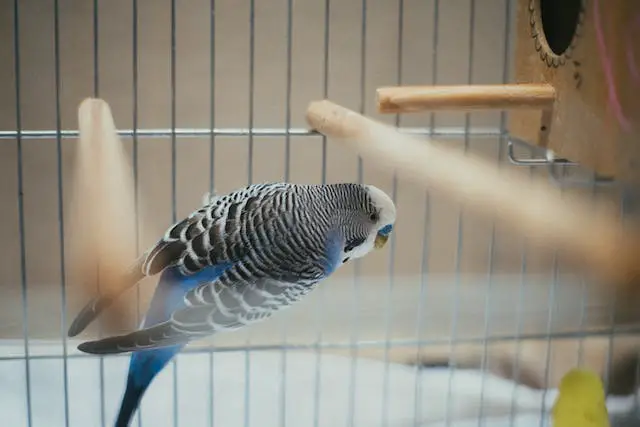Can you bring a bird on a plane? The answer is yes, but there are important considerations you need to know before taking your feathered friend on a flying adventure. Traveling with a bird can be a unique and rewarding experience, but it requires careful planning and preparation to ensure both their safety and the comfort of other passengers.
In this article, we will explore the necessary steps and guidelines to make flying with a bird a smooth and enjoyable journey. So, if you’ve ever wondered about bringing your beloved bird on a plane, let’s dive right in and discover everything you need to know about this avian adventure.
Table of Contents
Bringing A Bird On A Plane: Guidelines And Tips
Have you ever wondered if you can bring your feathered friend along on your next flight? Many people are curious about whether it’s possible to travel with a bird as a companion. The short answer is it depends. Let’s take a look on TSA’s website.

Also let’s have a look on the following tweet of TSA.
In this article, we will explore this topic in-depth and answer all your burning questions. So, if you’re eager to know if you can bring a bird on a plane, keep reading!
Why Would You Want to Bring a Bird on a Plane?
Before diving into the details, let’s discuss the reasons why someone might want to bring their bird on a plane. Here are a few common scenarios:
- Relocating:
If you’re moving to a new city or country, you might want your bird to accompany you on your journey.

w/4 Metal Perches, 2.6-pound Seed Capacity
- Vacation:
Some bird owners prefer not to leave their pets behind while they’re away on vacation, especially if they’ll be gone for an extended period.
- Exhibitions or Competitions:
Bird shows, exhibitions, or competitions can take place in different locations, and owners might want to showcase their birds or participate in such events.
Now that we understand why someone might want to bring a bird on a plane, let’s explore the various factors you need to consider.
Read More: About Tips for Going on a Vacation Without a 3 Month Old Baby
What Type of Bird Can You Bring on a Plane?
Not all birds are suitable for air travel. Many airlines have specific regulations regarding the types of birds they allow on board. Some common factors airlines consider when allowing birds on planes include:
- Size:
Airlines often have size restrictions for traveling birds. Smaller birds are generally easier to accommodate than larger ones.
- Noise Level:
Birds that are known for being loud, such as parrots or cockatoos, may not be permitted in the cabin due to potential disturbances to other passengers.
- Need for Specialized Care:
Birds that require specialized care or have specific health conditions may not be suitable for air travel. It’s crucial to consider the well-being of your bird during the journey.
Each airline has its own set of rules and regulations, so it’s essential to check with the airline you plan to fly with to ensure your bird can be accommodated.

Hopper Bird Feeder for Hanging, Garden Yard Outside Decoration
Checking with the Airline
When planning to bring a bird on a plane, it’s crucial to contact the airline directly to inquire about their policies and procedures. Here are some questions you may want to ask the airline:
1. Are birds allowed in the cabin or cargo hold?
2. What are the size restrictions for birds traveling in the cabin?
3. Do I need to provide any documentation or health certificates for my bird?
4. Are there any additional fees for traveling with a bird?
5. Are there any specific carriers or cages required for transporting birds?
6. What temperature and pressure conditions are maintained in the cargo hold?
Obtaining accurate information directly from the airline will help you make the necessary preparations and ensure a smooth travel experience for both you and your bird.
Preparing Your Bird for Air Travel
If you’ve confirmed with the airline that they allow birds on board, it’s time to prepare your feathered friend for the journey. Here are some important steps to follow:
Veterinary Check-up
Before traveling, take your bird to a veterinarian for a thorough check-up. The vet will ensure that your bird is in good health and fit for travel. They may also provide additional guidance on preparing your bird for the journey.
Travel Carrier
Invest in a sturdy and well-ventilated travel carrier that is airline-approved. Ensure that the carrier is spacious enough for your bird to move comfortably and has secure locks to prevent any accidental escapes. It’s advisable to introduce your bird to the carrier well in advance to familiarize them with the new environment.
Identification
Attach leg bands or other forms of identification to your bird’s legs or wings in case of separation or accidental escape during the journey.
Familiarity with the Carrier
Allow your bird to spend time in the carrier at home before the trip. Introduce familiar toys, treats, or a favorite blanket to make them feel more at ease during the journey.
Food and Water
Provide your bird with adequate food and water before the flight. It’s recommended to avoid giving a large meal immediately before travel to prevent any discomfort or accidents.

Fruit and Suet Feeder, 2 Suet Cake Capacity
Traveling with Your Bird
On the day of travel, make sure to arrive early at the airport to allow ample time for check-in and security procedures. Here are some additional tips for a smooth travel experience:
In-Cabin Travel
If your bird is small enough and meets the airline’s requirements, you may be able to bring them on board in a cabin carrier. It’s essential to follow the airline’s guidelines for securing the carrier under the seat in front of you. During the flight, it’s best to keep your bird’s carrier covered to minimize stress from unfamiliar surroundings.
Cargo Hold Travel
In some cases, larger birds or birds that don’t meet cabin requirements may need to travel in the cargo hold. This option should only be considered if it’s the best choice for your bird’s safety and well-being. Ensure that your bird’s carrier is sturdy and secure, with proper ventilation. Label the carrier with your contact information in case it gets separated from your luggage.
Tips to Ensure Your Bird’s Comfort and Safety
When traveling with a bird, it’s important to prioritize their comfort and safety throughout the journey. Here are some tips to help you achieve that:
1. Avoid subjecting your bird to extreme temperature conditions during travel. Ensure that the carrier is appropriately insulated.
2. Keep your bird’s carrier away from direct sunlight or drafty areas.
3. Use a cover or towel to partially cover the carrier to create a sense of security and reduce external stimuli.
4. Avoid opening the carrier during the flight, as this may increase the risk of escape.
5. Inform the flight attendants that you have a bird on board, ensuring they are aware of your situation.
By taking these precautions, you can help alleviate stress and ensure a safe and comfortable journey for your bird.
Traveling with a bird can be an exciting experience, but it requires careful planning and consideration. Before making any travel arrangements, check with your airline about their specific guidelines for traveling with birds. Prepare your bird for travel by providing necessary veterinary care and investing in an appropriate carrier.
During the journey, prioritize your bird’s comfort and safety by creating a familiar environment and following airline protocols. With proper preparation and attention to detail, you can bring your beloved bird along on your next adventure. Safe travels for both you and your feathered companion!

Squirrel Proof Bird Feeder with Weight-Activated Perches – 4LB Seed Capacity
Read More: About Can You Bring Light Bulbs on a Plane?
SNUCK MY BIRD ONTO THE PLANE!
Frequently Asked Questions (FAQs)
Yes, you can bring a bird on a plane, but it depends on certain factors and regulations set by the airline and destination. Different airlines and countries have their own rules regarding traveling with pets, including birds.
When traveling with a bird, you will usually need to comply with the following requirements:
Properly-sized and secure bird carrier or travel cage
Health certificate from a certified avian veterinarian
Confirmation of vaccination, if required by the destination
Compliance with airline-specific guidelines
Some airlines allow small birds to travel in the cabin with their owners, while others require them to be transported in the cargo hold. It is essential to check with the airline in advance to understand their specific policies and guidelines.
The restrictions for traveling with a bird in the cabin vary depending on the airline. Common restrictions include:
Size and weight limits for the carrier or cage
Limit on the number of birds allowed in the cabin
Prohibition of certain bird species
Requirement for the carrier to fit under the seat in front of you
If your bird needs to be transported in the cargo hold, you will typically need to:
Provide a suitable travel crate approved by the airline
Ensure the crate has proper ventilation
Include absorbent bedding material
Label the crate with your contact information
Flying with a bird does come with certain risks, especially if the bird is transported in the cargo hold. Birds can be sensitive to changes in temperature and air pressure, which can affect their well-being. Additionally, there is always a slight risk of injury or escape during travel.
No, it is generally not recommended to sedate your bird before flying. Sedation can pose additional risks to the bird’s health during the flight. It is best to consult with a veterinarian for advice on how to keep your bird calm and comfortable during travel.
To prepare your bird for air travel:
Get a thorough health check-up from an avian veterinarian
Acclimate your bird to its carrier or travel cage
Ensure the bird’s ID and contact information are securely attached to the carrier
Bring essential supplies, such as food, water, and familiar toys
Keep your bird’s comfort and safety a priority throughout the journey

Copper, Plexiglass Panels
Final Thoughts
Bringing a bird on a plane can be a complex and regulated process. Before bringing your feathered friend on board, it’s crucial to familiarize yourself with the airline’s specific policies and requirements. Typically, small birds may be allowed in the cabin with proper documentation and carrier, while larger birds might need to travel in the cargo hold.
To ensure a smooth journey for your bird, it’s essential to plan ahead, follow proper procedures, and prioritize their safety and well-being throughout the journey. Always consult with the airline and adhere to their guidelines when considering bringing a bird on a plane.






